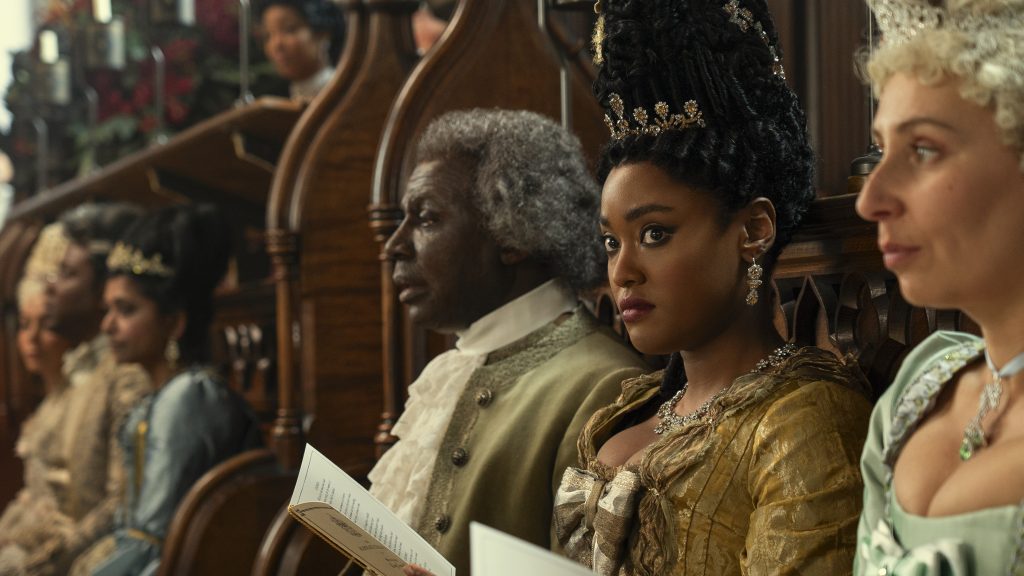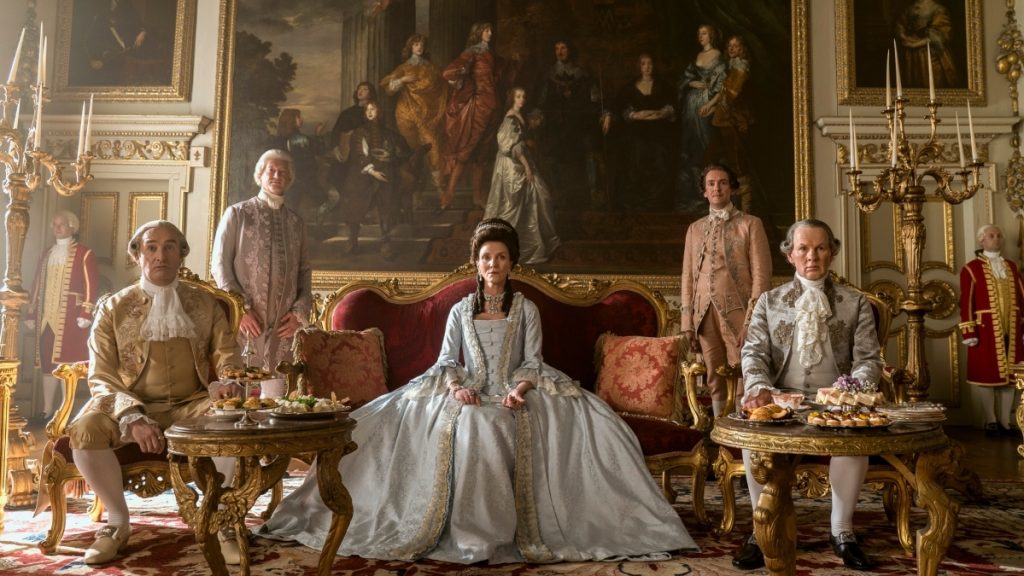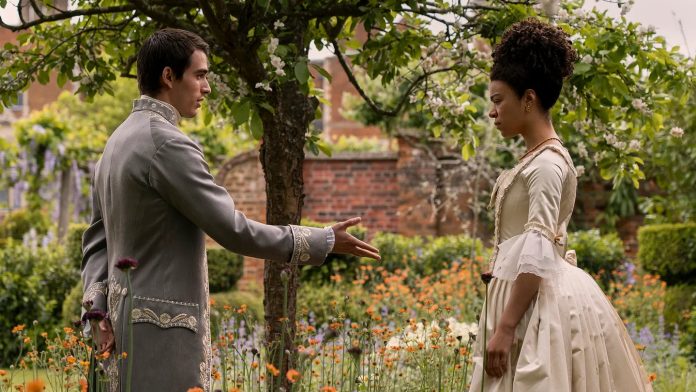With news of Bridgerton Season three still seemingly far in the future, fans of the series are yearning for more. And Queen Charlotte: A Bridgerton Story has delivered. While the Bridgerton source material spurned various spin-offs and prequels, Queen Charlotte delves into an area of the world that Julia Quinn has never previously attempted—that of the Queen’s history.
The show’s premise revolves around the young Charlotte (India Amarteifio), as she begins her life with King George III (Corey Mylchreest), with a parallel storyline of Queen Charlotte in the era of Bridgerton (Golda Rosheuvel). It’s a show that feels somewhat more sombre and melancholic than its predecessor, with a maturity that surpasses that of Bridgerton. However, a lot of Queen Charlotte’s success comes from elements that are present in the original show, but expanded upon. In this article, see some of the key aspects of Bridgerton that its spin-off refines.
The Reluctant Romance Trope
Over the course of Bridgerton’s first two series, we’ve seen some classic romance tropes incorporated. We saw Daphne and Simon (Phoebe Dynevor and Regé-Jean Page) embody the fake dating trope, while Anthony and Kate (Jonathan Bailey and Simone Ashley) undertook the slow burn journey of enemies-to-lovers. And now, with Charlotte and George, we see another variation of the reluctant romance trope: an arranged marriage. Across their love stories, the build-up stirs such passionate audience reactions when a love confession inevitably occurs, though Queen Charlotte has done it best.
In the new Bridgerton story, the reluctance comes from factors that go undiscovered for much of the narrative; this echoes Anthony’s arc, since his coldness towards marriage arises from factors beyond the woman in front of him. Rather, it’s the weight of familial responsibility, and his response to his father’s death. For George, it’s the recognition that due to his mental illness, he cannot provide the life he would want for his partner. The beauty in this romance however, comes from Charlotte’s willingness to take on that burden, and the tenderness that blooms between them in this choice. In Bridgerton, the King is only glimpsed. Though, the Queen’s adoration is made clear. Queen Charlotte reveals the very start of their story, showcasing their process to love. The satisfaction comes from the journey, and where it started—in this case, a charming conversation that takes place while one party is trying to run away from their wedding.
An Ensemble with Chemistry
Queen Charlotte delivers on showcasing strong chemistry. The frenetic energy and connection between Corey Mylchreest and India Amarteifio makes them shine together, and when you watch Queen Charlotte press junkets, it is clear that this connection and warmth is fostered by a solid friendship off-screen. This builds on the friendships and chemistry we have seen developed between the Bridgerton cast.
The Bridgerton stories have become renowned for their steamy sex scenes, and in particular, the appeal to the female gaze. Queen Charlotte is no different, with the chemistry between the romantic leads being as physical as it is emotional. Charlotte discovers her sexuality for the first time, much like Daphne in Bridgerton, but this exploration doesn’t repeat that narrative, offering new story beats and a different kind of sexiness.
However, Bridgerton also recognises that platonic chemistry is equally important, and these relationships are given the same attention and care. In the original series, this is mainly explored through the relationships between the Bridgerton siblings. Although there aren’t any sibling relationships dominating the screen in Queen Charlotte (though the Queen herself has a brother, Adolphus), the sisterhood between Lady Danbury (Arsema Thomas and Adjoa Andoh) and Queen Charlotte is keenly felt. The same can be said of the unfaltering loyalty of Brimsley (Sam Clemett) to Charlotte. Much like Penelope and Eloise’s (Nicola Coughlan and Claudia Jessie) friendship in Bridgerton, these relationships’ effects on these characters majorly impacts how they traverse the series. However, in Queen Charlotte it’s not only impactful, but essential to how Charlotte understands her place in this new world. If anything, her dynamics with Agatha and Brimsley are as important to the narrative as the romance at its centre.
Strong Female Characters
The romance genre and depictions of ‘strong female characters’ often come into conflict. To be a strong woman on screen, is to demonstrate that you don’t need a man. However, Bridgerton understands that you can still have fully realised female characters who desire relationships and thrive in them, and to be a strong female character doesn’t require you to be a moral person. The women in Bridgerton and Queen Charlotte often commit mistakes that hurt the people around them, or make the audience uncomfortable (Penelope’s Whistledown columns lead to the public ruin of her best friend, for example). However, the Bridgerton world curates these female characters with the agency to make those decisions for themselves. The women of Queen Charlotte continue this trend, showcasing multiple sides to themselves: Charlotte and Agatha are allowed to dance and laugh, and want to impress the people around them; they are allowed to get angry and frustrated and bitter; they can be cruel as well as kind. They embody many different ways of being a woman, both in contrast to each other and other women in the series such as Violet (Ruth Gemmell and Connie Jenkins-Greig) or Princess Augusta (Michelle Fairley).

Production and Costume Design
The Bridgerton world has always felt well established and lived in, even if it’s clear to Brits that it’s very rarely the real London that’s shown on screen. Queen Charlotte continues this strong sense of setting with elaborate location shooting at Belton House, Waddesdon Manor and Hampton Court Palace. We are invited into these glamorous ballrooms, into colourful gardens, and a stunning orangery; each location reminding us of the stately elegance of the characters we are journeying with.

Alongside the brilliant production design, the show’s costumes, designed by Lyn Paolo and Laura Frecon, also stun. As a prequel, the style of Queen Charlotte feels different from the standard regency wear in Bridgerton. The lingering influence of the Tudor era brings something to these costumes that isn’t seen in the later timeline of Bridgerton. And with the focus on characters immersed in the royal court, there are more jewels, higher hair-dos, and more room for extravagance and detail.
Soundtrack
Bridgerton subverted musical expectations when it decided to soundtrack its ball scenes with orchestral covers of contemporary pop songs. From Ariana Grande to Harry Styles, the biggest artists of our day have their hits transformed into orchestral versions at these dances. This trend has continued with Queen Charlotte, as the soundtrack features covers of the likes of Alicia Keys, Beyonce, and SZA. The choice of these specific artists feels more deliberate than in Bridgerton. The musical intentionality of highlighting black female artists adds an extra layer to the show, furthering its aim to herald black women at the show’s forefront, by using technical aspects as well as narrative ones.
A Diverse Cast
From day one, Bridgerton’s colour-blind casting has been a topic of conversation. Characters from the original novels such as Simon (Regé-Jean Page) and Lady Danbury (Adjoa Andoh) have been reimagined as black characters, but the show rarely addresses their race. In season two, this levelled up when Kate and Edwina Sheffield from the novel became the Sharma sisters (Simone Ashley and Charithra Chandran). Their Indian heritage was mentioned overtly, with the show depicting a traditional Haldi ceremony, as well as Edwina calling Kate as the Hindi honorific term ‘didi’. However, it still wasn’t discussed how these characters integrated into regency society with more ease than is historically accurate. While historical accuracy has never been integral to Bridgerton, the complete unwillingness to discuss these characters’ race was frustrating, especially given that the changes left some troubling implications in the relationship between Simon and Daphne.
However, Queen Charlotte is unafraid to tackle these challenges head-on, with Charlotte’s biracial identity being crucial to the narrative. Her welcome into the royal lineage is repeatedly referred to as “The Great Experiment,” and its effects on the wider community around her is keenly felt. It is Charlotte’s race that allows for other black characters, including the Danburys, to be invited into the social fold of The Ton. It explains how Lady Danbury achieved the high status and regard she has in Bridgerton, and also reflects the hard journey to achieve such social regard.
As well as racial diversity, Queen Charlotte also builds on the world’s LGBTQ+ representation. In Bridgerton, there are certainly queer-coded characters, but characters who are explicitly queer are never in the forefront. In contrast, Queen Charlotte has prominent gay characters, and the romance between Brimsley and Reynolds (Freddie Dennis) is second only to the one between Charlotte and George.
Overall, Queen Charlotte has a firm understanding of the elements that have made Bridgerton so beloved, and has sought to make these the show’s key areas of focus. With Bridgerton season three on the horizon, let’s hope that showrunners continue this upward trend, with the show’s cinematic universe strengthening with each season.
Queen Charlotte: A Bridgerton Story is available to stream on Netflix.
Words by Rehana Nurmahi
Support The Indiependent
We’re trying to raise £200 a month to help cover our operational costs. This includes our ‘Writer of the Month’ awards, where we recognise the amazing work produced by our contributor team. If you’ve enjoyed reading our site, we’d really appreciate it if you could donate to The Indiependent. Whether you can give £1 or £10, you’d be making a huge difference to our small team.
